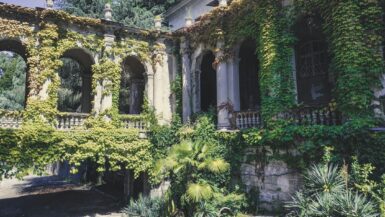Introduction
The Sedlec Ossuary, located in Kutná Hora, Czech Republic, is a unique and macabre tourist attraction that draws visitors from around the world. Known as the “Bone Church,” the ossuary is a small chapel adorned with the bones of an estimated 40,000 to 70,000 people. It is a place where death and art intertwine, creating a hauntingly beautiful and thought-provoking experience for those who visit.
The importance of the Sedlec Ossuary as a tourist attraction and historical site cannot be overstated. It is a testament to the rich history and cultural heritage of the Czech Republic, and it serves as a reminder of the fragility and transience of human life. The ossuary’s unique design and macabre decorations make it a must-see destination for travelers seeking something out of the ordinary.
History of the Ossuary: How it all began
The story of the Sedlec Ossuary begins with the Sedlec Monastery and its cemetery. The monastery was founded in the 12th century and quickly became a popular burial site due to its association with the Cistercian Order. Over the centuries, the cemetery became overcrowded, and in the 13th century, the decision was made to expand the burial grounds.
In 1278, King Otakar II sent the abbot of the Sedlec Monastery to the Holy Land. Upon his return, the abbot brought back a handful of soil from Golgotha, the site of Jesus’ crucifixion. This soil was sprinkled over the cemetery, making it a highly desirable place to be buried. As a result, the cemetery became even more crowded, and in the 15th century, a Gothic church was built on the site to accommodate the growing number of burials.
The Legend of the Ossuary: Separating Fact from Fiction
The Sedlec Ossuary is surrounded by numerous myths and legends, many of which have been perpetuated by tour guides and popular culture. One of the most common myths is that the bones in the ossuary belong to victims of the Black Death. While it is true that the Black Death ravaged Europe in the 14th century, the bones in the ossuary date back much further.
In reality, the bones in the ossuary come from a variety of sources. Some were exhumed from the overcrowded cemetery, while others were brought from other burial sites in the region. The bones were then arranged and displayed in the ossuary as a way to make room for new burials and to honor the dead.
The Design of the Ossuary: An Architectural Marvel
The Sedlec Ossuary is a stunning example of Gothic and Baroque architecture. The chapel itself is a small, rectangular building with a vaulted ceiling and a central nave. The walls and ceiling are adorned with intricate designs made from human bones, including chandeliers, coats of arms, and even a bone chalice.
The ossuary is divided into several rooms and chapels, each with its own unique design and bone decorations. The most famous of these is the Schwarzenberg Chapel, which features a massive chandelier made from every bone in the human body. Other notable rooms include the All Saints Chapel, which is adorned with skulls and bones arranged in the shape of a chalice, and the Chapel of the Holy Cross, which features a large cross made entirely of bones.
The Bones: A Closer Look at the Macabre Decorations
The bone decorations in the Sedlec Ossuary are truly a sight to behold. The bones are arranged in intricate patterns and designs, creating a macabre yet strangely beautiful display. Skulls are stacked in pyramids, femurs are used to create arches, and vertebrae are arranged in decorative patterns on the walls.
The techniques used to arrange and display the bones are a testament to the skill and artistry of the craftsmen who created them. The bones are carefully cleaned and bleached before being arranged, and they are held together with wire and cement. The result is a hauntingly beautiful display that is both eerie and awe-inspiring.
The Significance of the Skulls: Symbolism and Meaning
Skulls are the most prominent bone decoration in the Sedlec Ossuary, and they hold a deep cultural and religious significance. In many cultures, skulls are seen as a symbol of death and mortality, but they are also associated with rebirth and transformation. In the Christian tradition, skulls are often used as a reminder of the transience of human life and the need to prepare for the afterlife.
In the context of the Sedlec Ossuary, the skull decorations serve as a memento mori, a reminder of the inevitability of death. They also serve as a symbol of the Catholic belief in the resurrection of the dead and the hope of eternal life. The skulls are arranged in various patterns and designs, creating a visually striking display that is both macabre and thought-provoking.
The Religious Context: The Role of the Church in the Ossuary’s History
The Sedlec Ossuary has deep religious significance for Catholics and other Christians. The ossuary is located on the grounds of the Sedlec Monastery, which is still an active Catholic church. The Catholic Church has been involved in the ossuary’s creation and maintenance since its inception, and it continues to play a role in its preservation and restoration.
The use of human bones for decoration in the ossuary has been a source of controversy and debate. Some argue that it is disrespectful to the dead and goes against the teachings of the Catholic Church. Others see it as a powerful reminder of the fragility of human life and the need to prepare for the afterlife. The Catholic Church has taken steps to address these concerns, including the installation of a plaque in the ossuary that explains the history and purpose of the bone decorations.
The Visitors: Who Comes to See the Bone Church and Why
The Sedlec Ossuary attracts a wide range of visitors, from history buffs and art enthusiasts to those with a morbid curiosity. The demographic breakdown of visitors is diverse, with people of all ages and backgrounds coming to see the bone church. Many visitors are drawn to the ossuary because of its unique and macabre nature, while others are interested in its historical and cultural significance.
The impact of tourism on the ossuary and its surrounding community cannot be overstated. The influx of visitors has brought economic benefits to the region, including increased revenue for local businesses and job opportunities for residents. However, it has also put a strain on the ossuary’s infrastructure and raised concerns about the preservation of the bone decorations.
The Controversy: Ethical Concerns Surrounding the Ossuary
The use of human bones for decoration in the Sedlec Ossuary has raised ethical concerns among some people. Critics argue that it is disrespectful to the dead and goes against the principles of human dignity and respect. They also question the legality of using human remains for artistic purposes.
Proponents of the ossuary argue that it is a unique and historically significant site that should be preserved for future generations. They point to the ossuary’s cultural and religious significance and argue that it serves as a powerful reminder of the fragility and transience of human life.
The Restoration: How the Ossuary is Maintained and Preserved
The Czech government and the Catholic Church have taken steps to address the ethical concerns surrounding the Sedlec Ossuary and ensure its preservation for future generations. The ossuary has undergone several restoration projects over the years, including the installation of a new ventilation system and the reinforcement of the chapel’s structure.
The bones in the ossuary are carefully cleaned and maintained to prevent decay and deterioration. The ossuary is also monitored regularly to ensure that the bone decorations are not damaged or stolen. These efforts have been largely successful in preserving the ossuary and its bone decorations for future generations.
Beyond the Ossuary: Other Macabre Attractions in Prague
Prague, the capital city of the Czech Republic, is home to several other macabre and unusual tourist attractions. One of the most famous is the Prague Castle, which houses the remains of several Czech kings and queens. The castle also features a torture chamber and a collection of medieval weapons.
Another popular attraction is the Old Jewish Cemetery, which is the final resting place of thousands of Jews who lived in Prague. The cemetery is known for its crowded and dilapidated graves, which create a hauntingly beautiful and eerie atmosphere.
Conclusion
The Sedlec Ossuary is a unique and macabre tourist attraction that draws visitors from around the world. Its history, design, and bone decorations make it a must-see destination for those seeking something out of the ordinary. While the use of human bones for decoration has raised ethical concerns, the ossuary continues to be a powerful reminder of the fragility and transience of human life. It is a testament to the rich history and cultural heritage of the Czech Republic, and it serves as a reminder of the enduring appeal and cultural relevance of macabre tourism.




Leave a reply